As ophthalmology marketing becomes increasingly competitive, practices need effective strategies to stand out. Americans spend a significant portion of their day staring at different screens. Mobile phone screens alone take around 4.6 hours of our time per day. With this much strain on the eyes, people will definitely need an ophthalmologist sooner or later. However, with over 18,500 ophthalmologists in the US, it’s hard to stand out and make people choose you over the competition. This is where ophthalmologist marketing strategies come in.
In this industry, it’s important not simply as a driver of more business but also to make healthcare accessible to people’s needs. We’ll dive deep into the tactics and techniques that will help you grow your practice and stand out in a crowded market.
Why Ophthalmology Marketing Is Essential for Practice Success
Ophthalmology marketing is the process of promoting an ophthalmology practice to attract new patients and retain existing ones through various digital channels. It encompasses a range of strategies and tactics, including search engine optimization, social media marketing, email marketing, and online advertising.
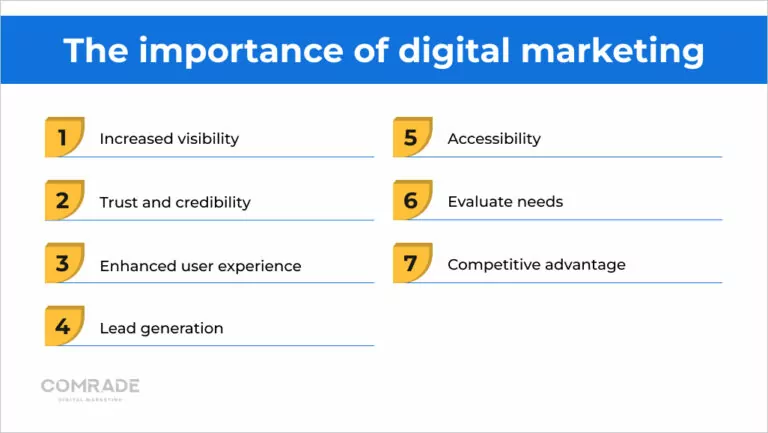
A targeted online presence offers several advantages:
- Increased visibility: A website, social profiles, and online ads raise your practice’s visibility. This brings your services and expertise to people searching online. It exposes potential patients to your practice when eye issues arise.
- Trust and credibility: Professional ophthalmology digital marketing assets build trust by demonstrating your practice’s legitimacy. High-quality content educates readers and shows your knowledge. Consistent updates maintain credibility as a source patients can rely on.
- Enhanced user experience: Your website should offer easy navigation and helpful information. It allows patients to conveniently research their specialty services and view provider bios from any device. Smooth digital interactions improve their experience.
- Lead generation: Strategic content and search engine optimization bring qualified prospects to your site. Forms then allow capturing patient info as online leads. These leads can convert into booked appointments and new patients.
- Accessibility: People now conduct online research for local businesses overnight, on weekends, and holidays. A robust online presence ensures your practice remains front of mind whenever eye health questions surface.
- Evaluate needs: Analyzing website traffic provides insight into reader interests. You gain perspective into the most common eye concerns in your community. This helps enhance offerings accordingly.
- Competitive advantage: Few ophthalmology practices dedicate strategic efforts online, and those who do see an opportunity to attract more patients and increase patient retention by standing out from passive competitors. Marketing expertise differentiates a practice.
10 Digital Marketing Strategies for Ophthalmologists
We have already mentioned the importance of having an online presence. But with an online presence comes strategies that shine a light on the darkness. The goal is to ensure ophthalmologists can effectively put their services in front of potential clients.
1. Create a Google Business Profile
A Google Business Profile allows eye care practices to claim and manage their business listings directly on Google. It encompasses features like business name, address, phone number, services provided, and hours of operation.
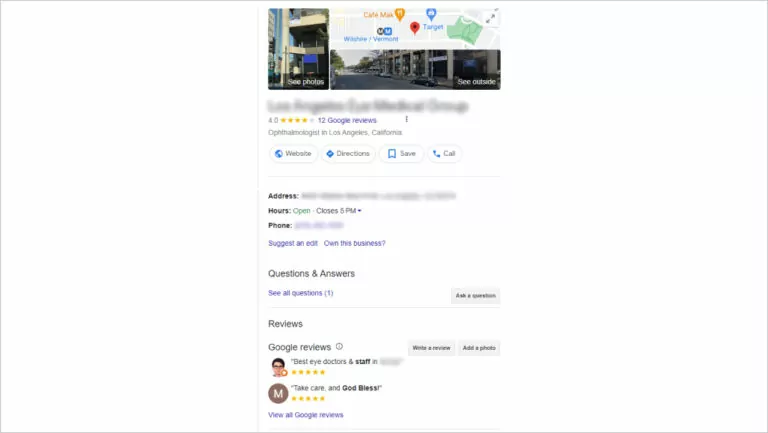
Claiming and verifying ownership of the profile through Google’s process ensures this vital information appears accurately across Google searches and maps. When consumers look for eye doctors, this listing ensures your practice appears prominently.
Once you’ve claimed and verified your GBP listing, you should:
- Add high-quality photos of your practice and staff.
- Use accurate and up-to-date information, such as your practice’s hours, contact details, and services offered.
- Respond promptly to patient reviews and questions.
- Use relevant keywords in your GBP description to improve your practice’s visibility in Google search results.
2. Optimize Your Local SEO
Local SEO involves on-page and off-page best practices to elevate an eye care practice’s search visibility within a given geographic location or radius. For example, when a patient in New York City searches for “best eye doctor near me” on Google, your practice can appear in the search results if you have optimized your local SEO.
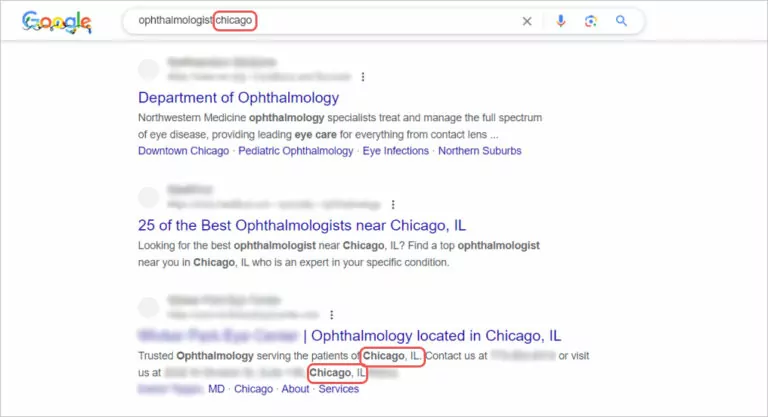
Here are some of the best local SEO practices to help your ophthalmology practice rank higher in local search results:
- Use location-specific keywords in your website content, such as “New York City ophthalmologist” or “Manhattan eye doctor.”
- Use consistent NAP (Name, Address, and Phone Number) across all online directories and listings.
- Build high-quality, relevant backlinks from other local businesses and websites.
- Use schema markup to provide additional context to search engines about your practice’s location and services.
- Regularly post updates and offers on your social media accounts to engage with your local audience.
- Use local directories such as Yelp and Healthgrades to promote your practice and engage with patients.
- Monitor and respond to patient reviews on online directories and social media.
Stop guessing and start ranking! Enhance your online presence with specialized ophthalmology SEO and convert more visitors into loyal patients.
3. Create an Optimized Website
An optimized ophthalmology website design can help you rank higher in search engine results, provide a better user experience, and showcase your expertise and services to potential patients.

One of the key benefits of an optimized website is that it can help you rank for relevant keywords and phrases, such as “New York City ophthalmologist” or “best eye doctor in Manhattan.” This can help you attract more traffic to your website and increase the chances of converting visitors into patients.
A good website is should include high-quality images. You should also make sure it loads quickly to enhance usability and reduce bounce rate. Furthermore, ensure the site is mobile-friendly, fits all screens, and has a responsive design for mobile screens. Consider incorporating pre-filled contact or appointment forms. Then, produce fresh, helpful content to educate clients and get more traffic to your website.
4. Get More Online Reviews
Word-of-mouth advocacy from satisfied patients carries tremendous power in building trust and credibility. You need to strategically request reviews from those who’ve completed treatments, especially on prominent rating sites like Google, Facebook, and HealthGrades, to give future patients social proof and build an online reputation.
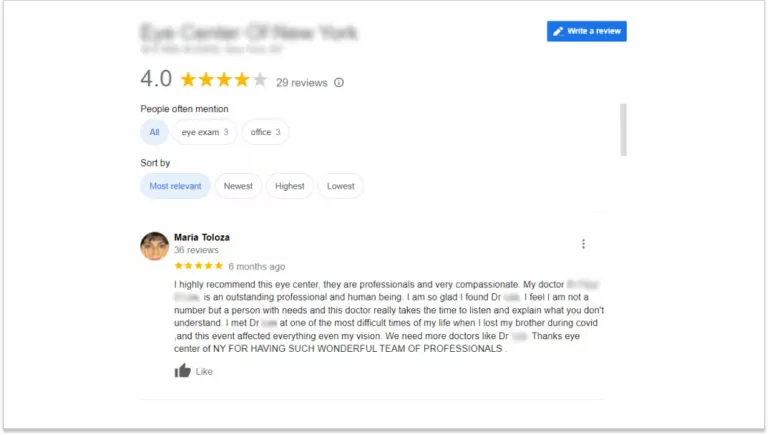
You can tactfully ask patients during checkout or via email/text reminders to publicly share their experience on popular sites. Furthermore, provide patients with a direct link to the review platforms and include a QR code or other easy-to-use interface.
Once you start receiving more online reviews, it’s important to handle them effectively for reputation management. Check your Google My Business listing and other review platforms regularly to see if new reviews have been left (consider using review management software to streamline the process of collecting and responding to reviews.). Then, respond to all reviews to show that you value your patients’ feedback and care about their experiences. You should also be authentic and professional. Avoid getting defensive or argumentative; instead, focus on resolving issues or addressing any concerns.
5. Write Useful and Engaging Content
The days of ophthalmologists involve more than procedures alone; they also involve the examination and education of their clients. While they can educate clients during the whole process, content serves well by translating the talents into terms clients — existing and potential — can all understand.
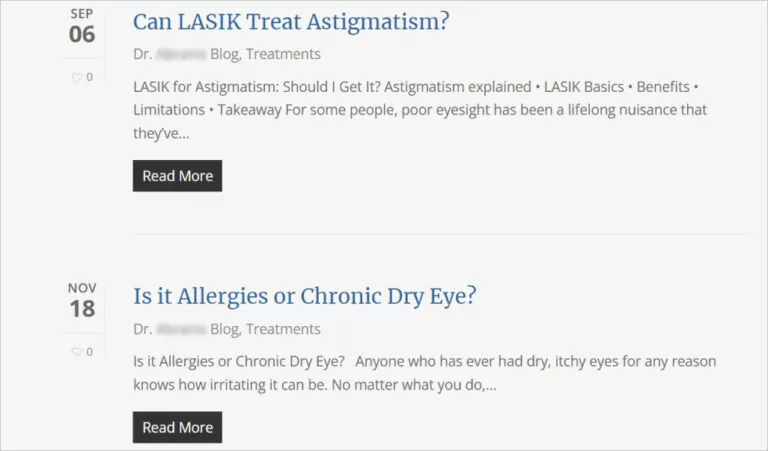
You can create:
- Blog posts explaining diseases like glaucoma, cataracts, and dry eyes in layperson’s terms.
- Articles introducing new specialists and their areas of focus.
- Video or illustrated guides to routines like eyedrop instillation or post-op care.
- Infographics summarizing common procedures or diagnosis timelines.
- Quizzes testing reader knowledge of eye health best practices.
- Interviews with leading researchers discussing promising advances.
- Educational pamphlets/e-books for specific conditions or seasons like summer sun protection.
6. Optimize Your Content for SEO
While helpful content is important, optimizing it properly ensures the information reaches those seeking it online. Proper optimization helps ensure anyone researching symptoms, procedures, or providers locally will encounter that content. This could be a person simply curious about new lens implant options or someone with concerns about sudden vision changes.
Responsive, reader-focused material matched closely to search intent and localized keyword variations gives these individuals the clarity they need from a trusted healthcare source.
Here are some ways to optimize your content for SEO:
- Conduct thorough keyword research to identify the most relevant and commonly searched terms related to your ophthalmology practice.
- Integrate these keywords into your content naturally and organically, using variations and synonyms to avoid keyword stuffing.
- Use header tags (H1, H2, H3, etc.) to break up your content and highlight key points and sections.
- Optimize your images using descriptive file names and alt tags, and ensure they are compressed to load quickly.
- Use internal linking to connect your content and provide a smooth user experience for your readers.
- Write compelling and descriptive meta descriptions for each piece of content, as this can improve your search engine rankings and increase your online visibility.
- Ensure that your content is optimized for mobile devices, as this can improve your search engine rankings and increase your online visibility.

Looking to scale or increase your revenue? SEO is proven to grow your business
7. Be Active on Social Media
Social media platforms like Facebook, Instagram, Twitter, LinkedIn, and YouTube provide engaging ways to connect with both patients and peers. There are 4.9 billion users worldwide who rely on one or more social networks daily to stay informed. These channels allow ophthalmologists to use different formats to showcase their expertise to another type of audience in real-time.
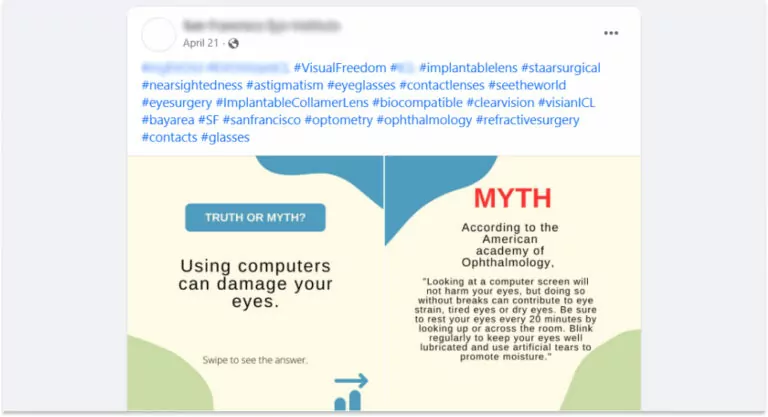
Social media lets you post news and updates about your practice, such as new technology, staff additions, and community events.
It allows you to share educational information about eye health, diseases, and treatments to help patients better understand their conditions on your feed or story.
You can also respond to comments and messages, and engage with your followers in real-time to build a stronger relationship and improve patient satisfaction.
Furthermore, you can upload patient testimonials to help with reputation marketing. Upload links to your practice’s online scheduling platform to make it easier for patients to schedule appointments online. Also, use relevant hashtags to increase the visibility of your posts and attract new followers. To get more from the channels, collaborate with social media influencers in your community to increase your practice’s visibility and reach a wider audience. Share patient-generated content, such as photos and videos, to showcase your practice’s work and build trust with potential patients.
8. Start an Email Marketing Campaign
Email marketing remains one of the most effective digital channels, with an average of 3,600% higher ROI than social media. Ophthalmologists can send newsletters, appointment reminders, surveys, and promotional emails.
For every dollar an ophthalmologist spends on email marketing, they make between 30 – 42$.
Before starting an email marketing campaign, you’ll need to build an email contact list. This list should include subscribers who have opted-in to receive emails from your practice. This can be done via signup forms, webinar registration, social follow buttons, and more. Then, segment them. Segmentation then enables you to divide your email list into smaller groups based on procedure history, location, age, and other demographics to tailor your emails to specific groups and increase their effectiveness.
9. Start and Advertising Campaign
An advertising campaign involves promoting a business using paid digital channels like search, social media, and display ads. An ad campaign expands the reach of your practice beyond organic searches. It also allows you to target specific audiences by location, age, and interest with pinpoint accuracy.

The most popular types of ads ophthalmologists can use include:
- Search ads: They allow you to advertise your practice on search results of platforms like Google Ads or Bing Ads and their partner websites, so they appear for relevant keyword searches.
- Social ads: Social channels like Facebook, Instagram, and LinkedIn offer powerful advertising tools that can help you reach a targeted audience.
You need to optimize your ad campaign to ensure that your advertising budget is well-spent. Here are some tips for optimizing your ad campaign:
- Define your goals, such as increasing brand awareness or driving more conversions.
- Use demographic and behavioral targeting to reach the right audience for your ads.
- Use attention-grabbing headlines and ad copy to engage your audience.
- Bid on the right keywords and ad placements to maximize your ad visibility.
- Continuously monitor your ad performance and make adjustments as needed.
10. Use Strong Marketing Materials
While digital efforts expand a practice’s reach, traditional marketing materials still play an important role. These methods can help you reach a wider audience, increase brand awareness, and drive more conversions. They can be distributed through various channels, such as mailers, newspaper ads, and outdoor advertising.
For your practice, you can create brochures that detail your services to new and existing patients or flyers to promote seasonal events like dry eye seminars. You can also opt for posters to communicate important health messages for public spaces and coupon mailers to drive traffic during slower months. Business cards can also be used to reinforce your brand at conferences and talks to clients and professionals.
Bonus Tip: Hire a Marketing Agency
If you want to take your online outreach to the next level, consider hiring a marketing agency. A marketing agency can help you develop a comprehensive online marketing strategy tailored to your needs and goals. This includes conducting market research, identifying your target audience, and creating a content calendar to help you stay in mind with prospective patients.
In addition to these core services, a marketing agency can provide a range of other services to help you improve your online outreach. This includes website design and development, email marketing, and social media management.
One of the biggest advantages of working with a marketing agency is their ability to provide expertise and resources that are simply unavailable with DIY methods.
When you work with a marketing agency, you have access to a team of professionals who are dedicated to helping you achieve your goals. This means you can focus on what you do best – providing high-quality eye care to your patients – while the marketing agency handles the rest.
In contrast, DIY methods often require significant time and effort to produce subpar results. This can be especially challenging for busy eye care professionals who are already stretched thin. Furthermore, outsourcing your online marketing efforts to a marketing agency saves you time and energy while still achieving the results you want.

Climb the search engine ladder - rank higher on Google with SEO solutions guaranteed to work
Grow Your Ophthalmology Practice with Proven Medical Marketing Strategies
These ophthalmology marketing strategies can transform your practice’s digital presence and patient acquisition. For comprehensive ophthalmology practice marketing support. But don’t stop there! You can opt for the services of a professional digital marketing company like Comrade Digital Marketing Agency.
Our team of experts will work with you to create a customized marketing plan that leverages the latest technologies and trends to drive growth and reach your goals. So why wait? Contact us today to learn more and take the first step towards growing your practice with Comrade!

